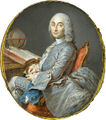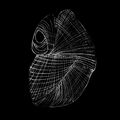Template:Selected anniversaries/June 17: Difference between revisions
No edit summary |
No edit summary |
||
| Line 1: | Line 1: | ||
<gallery> | <gallery> | ||
||1704 | ||1704: John Kay born ... engineer, invented the Flying shuttle (d. 1780) | ||
File:César François Cassini de Thury.jpg|link=César-François Cassini de Thury (nonfiction)|1714: Astronomer and cartographer [[César-François Cassini de Thury (nonfiction)|César-François Cassini de Thury]] born. In 1744, he will begin the construction of a great topographical map of France, one of the landmarks in the history of cartography. Completed by his son Jean-Dominique, Cassini IV and published by the Académie des Sciences from 1744 to 1793, its 180 plates will be known as the Cassini map. | File:César François Cassini de Thury.jpg|link=César-François Cassini de Thury (nonfiction)|1714: Astronomer and cartographer [[César-François Cassini de Thury (nonfiction)|César-François Cassini de Thury]] born. In 1744, he will begin the construction of a great topographical map of France, one of the landmarks in the history of cartography. Completed by his son Jean-Dominique, Cassini IV and published by the Académie des Sciences from 1744 to 1793, its 180 plates will be known as the Cassini map. | ||
||John Henry "Professor" Pepper | ||1821: John Henry "Professor" Pepper born ... scientist and inventor who toured the English-speaking world with his scientific demonstrations. He entertained the public, royalty, and fellow scientists with a wide range of technological innovations. He is primarily remembered for developing the projection technique known as Pepper's ghost, building a large-scale version of the concept by Henry Dircks. Pic. | ||
||1832 | ||1832: William Crookes born ... chemist and physicist. | ||
File:Charles Grafton Page.jpg|link=Charles Grafton Page (nonfiction)|1859: Inventor and crime-fighter [[Charles Grafton Page (nonfiction)|Charles Grafton Page]] uses [[Gnomon algorithm]] to forecast and prevent [[crimes against mathematical constants]]. | File:Charles Grafton Page.jpg|link=Charles Grafton Page (nonfiction)|1859: Inventor and crime-fighter [[Charles Grafton Page (nonfiction)|Charles Grafton Page]] uses [[Gnomon algorithm]] to forecast and prevent [[crimes against mathematical constants]]. | ||
||1876 | ||1876: American Indian Wars: Battle of the Rosebud: One thousand five hundred Sioux and Cheyenne led by Crazy Horse beat back General George Crook's forces at Rosebud Creek in Montana Territory. | ||
||1877 | ||1877: American Indian Wars: Battle of White Bird Canyon: The Nez Perce defeat the U.S. Cavalry at White Bird Canyon in the Idaho Territory. | ||
||1885 | ||1885: The Statue of Liberty arrives in New York Harbor. | ||
||1898 | ||1898: Carl Hermann born ... physicist and academic. | ||
||1901 | ||1901: The College Board introduces its first standardized test, the forerunner to the SAT. | ||
||Hubert Schardin Hermann Reinhold | ||1902: Hubert Schardin Hermann Reinhold born ... ballistics expert, engineer and academic who studied in the field of high-speed photography and cinematography. Pic. | ||
||Sir William Vallance Douglas Hodge | ||1903: Sir William Vallance Douglas Hodge born ... mathematician, specifically a geometer. His discovery of far-reaching topological relations between algebraic geometry and differential geometry—an area now called Hodge theory and pertaining more generally to Kähler manifolds—has been a major influence on subsequent work in geometry. | ||
||Hans Maass | ||1911: Hans Maass born ... mathematician who introduced Maass wave forms (Maass 1949) and Koecher–Maass series (Maass 1950) and Maass–Selberg relations and who proved most of the Saito–Kurokawa conjecture. | ||
||1920 | ||1920: François Jacob born ... biologist and geneticist, Nobel Prize laureate. | ||
File:Alexander Shulgin 2009.jpg|link=Alexander Shulgin (nonfiction)|1925: Pharmacologist and chemist [[Alexander Shulgin (nonfiction)|Alexander Shulgin]] born. He will discover, synthesize, and personally bioassay over 230 psychoactive compounds for their psychedelic and entactogenic potential. | File:Alexander Shulgin 2009.jpg|link=Alexander Shulgin (nonfiction)|1925: Pharmacologist and chemist [[Alexander Shulgin (nonfiction)|Alexander Shulgin]] born. He will discover, synthesize, and personally bioassay over 230 psychoactive compounds for their psychedelic and entactogenic potential. | ||
| Line 34: | Line 34: | ||
File:Nikolai Tesla 1896.jpg|link=Nikola Tesla (nonfiction)|1939: Electrical engineer [[Nikola Tesla (nonfiction)|Nikola Tesla]] uses ultra-low-frequency electrical current to detect and prevent [[crimes against mathematical constants]]. His work will later be useful in detecting and removing the [[Watergate scandal]] virus. | File:Nikolai Tesla 1896.jpg|link=Nikola Tesla (nonfiction)|1939: Electrical engineer [[Nikola Tesla (nonfiction)|Nikola Tesla]] uses ultra-low-frequency electrical current to detect and prevent [[crimes against mathematical constants]]. His work will later be useful in detecting and removing the [[Watergate scandal]] virus. | ||
||1940 | ||1940: Arthur Harden dies ... biochemist and academic, Nobel Prize laureate. | ||
||1944 | ||1944: Iceland declares independence from Denmark and becomes a republic. | ||
||1952 | ||1952: Jack Parsons dies ... chemist and engineer. | ||
||1957 | ||1957: J. R. Williams dies ... cartoonist. | ||
||1967 | ||1967: The People's Republic of China announces a successful test of its first thermonuclear weapon. | ||
File:Nixon April-29-1974.jpg|link=Watergate scandal (nonfiction)|1972: [[Watergate scandal (nonfiction)]]: Five White House operatives are arrested for burgling the offices of the Democratic National Committee, in an attempt by some members of the Republican party to illegally wiretap the opposition. | File:Nixon April-29-1974.jpg|link=Watergate scandal (nonfiction)|1972: [[Watergate scandal (nonfiction)]]: Five White House operatives are arrested for burgling the offices of the Democratic National Committee, in an attempt by some members of the Republican party to illegally wiretap the opposition. | ||
||1982 | ||1982: Roberto Calvi dies ... banker. | ||
||Milbourne Christopher | ||1984: Milbourne Christopher dies ... illusionist, magic historian, and author. | ||
||1985 | ||1985: STS-51-G Space Shuttle Discovery launches carrying Sultan bin Salman bin Abdulaziz Al Saud, the first Arab and first Muslim in space, as a payload specialist. | ||
||Thomas Samuel Kuhn | ||1996: Thomas Samuel Kuhn dies ... physicist, historian and philosopher of science whose controversial 1962 book The Structure of Scientific Revolutions was influential in both academic and popular circles. Pic. | ||
||2001 | ||2001: Donald J. Cram dies ... chemist and academic, Nobel Prize laureate. | ||
||2012 | ||2012: Nathan Divinsky dies ... mathematician and chess player. | ||
File:Pilgrim.jpg|link=Pilgrim (image) (nonfiction)|2018: Steganograpic analysis of ''[[Pilgrim (image) (nonfiction)|Pilgrim]]'' unexpectedly reveals "at least two hundred kilobytes" of previously unknown [[Gnomon algorithm]] functions. | File:Pilgrim.jpg|link=Pilgrim (image) (nonfiction)|2018: Steganograpic analysis of ''[[Pilgrim (image) (nonfiction)|Pilgrim]]'' unexpectedly reveals "at least two hundred kilobytes" of previously unknown [[Gnomon algorithm]] functions. | ||
</gallery> | </gallery> | ||
Revision as of 09:28, 10 October 2018
1714: Astronomer and cartographer César-François Cassini de Thury born. In 1744, he will begin the construction of a great topographical map of France, one of the landmarks in the history of cartography. Completed by his son Jean-Dominique, Cassini IV and published by the Académie des Sciences from 1744 to 1793, its 180 plates will be known as the Cassini map.
1859: Inventor and crime-fighter Charles Grafton Page uses Gnomon algorithm to forecast and prevent crimes against mathematical constants.
1925: Pharmacologist and chemist Alexander Shulgin born. He will discover, synthesize, and personally bioassay over 230 psychoactive compounds for their psychedelic and entactogenic potential.
1932: Bonus Army: Around a thousand World War I veterans amass at the United States Capitol as the U.S. Senate considers a bill that would give them certain benefits.
1939: Electrical engineer Nikola Tesla uses ultra-low-frequency electrical current to detect and prevent crimes against mathematical constants. His work will later be useful in detecting and removing the Watergate scandal virus.
1972: Watergate scandal (nonfiction): Five White House operatives are arrested for burgling the offices of the Democratic National Committee, in an attempt by some members of the Republican party to illegally wiretap the opposition.
2018: Steganograpic analysis of Pilgrim unexpectedly reveals "at least two hundred kilobytes" of previously unknown Gnomon algorithm functions.






